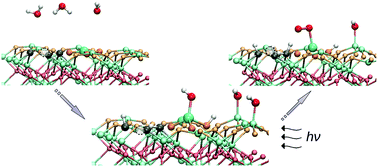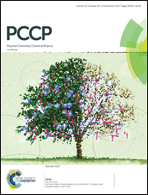Surface Fe vacancy defects on haematite and their role in light-induced water splitting in artificial photosynthesis†
Abstract
Haematite (α-Fe2O3) is a potential candidate for photo-electrochemical water splitting. It is abundant and its electronic properties fit those needed for this kind of device. However, very little is known about the intermediate steps of this photon-induced water splitting process. We propose here that surface iron vacancies can be the main defects responsible for the activity of haematite in the photoelectrochemical reaction. We perform DFT+U calculations and explicitly add holes to show that these defects are common in iron-terminated (0001) surfaces. As holes tend to be localized at these centers, they should be available for the dissociation of water under sunlight. Our calculations also reveal that the water adsorption energy close to the vacancy is 1 eV stronger than far from it, and when the formation of multi-holes is considered, a thermodynamically stable water dissociation mechanism can be developed. We determined that both Fe![[double bond, length as m-dash]](https://www.rsc.org/images/entities/char_e001.gif) O and Fe–OOH intermediate steps are stable, although Fe–OOH quickly leads to the formation of O2, having therefore a very short lifetime. Phonon calculations on these structures reveal the appearance of peaks in the 800–900 cm−1 frequency range only for the intermediate steps, connected to Fe
O and Fe–OOH intermediate steps are stable, although Fe–OOH quickly leads to the formation of O2, having therefore a very short lifetime. Phonon calculations on these structures reveal the appearance of peaks in the 800–900 cm−1 frequency range only for the intermediate steps, connected to Fe![[double bond, length as m-dash]](https://www.rsc.org/images/entities/char_e001.gif) O vibrations, in agreement with recent measurements.
O vibrations, in agreement with recent measurements.



 Please wait while we load your content...
Please wait while we load your content...